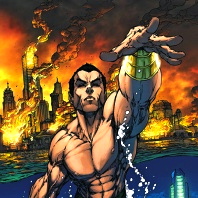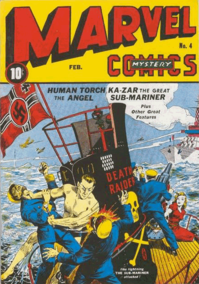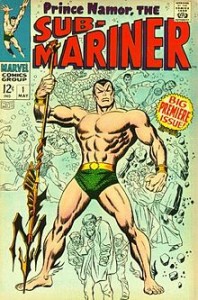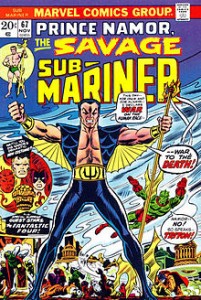Namor

The Submariner 1960’s Cartoon: “The Thing From Space”
The Thing from Space, No Escape for Namor, A Prince Dies Fighting.
 Prince Namor. Cover art for Sub-Mariner #1 (Aug. 2007), by Michael Turner
Prince Namor. Cover art for Sub-Mariner #1 (Aug. 2007), by Michael Turner
Namor the Sub-Mariner (Namor McKenzie) is a fictional character comic book superhero appearing in books published by Marvel Comics. Debuting in early 1939, the character was created by writer–artist Bill Everett for Funnies Inc., one of the first “packagers” in the early days of comic books that supplied comics on demand to publishers looking to enter the new medium. Initially created for the unreleased comic Motion Picture Funnies Weekly, the Sub-Mariner first appeared publicly in Marvel Comics #1 (Oct. 1939) — the first comic book from Timely Comics, the 1930’s-1940’s predecessor of the company Marvel Comics. During that period, known to historians and fans as the Golden Age of Comic Books, the Sub-Mariner was one of Timely’s top three characters, along with Captain America and the original Human Torch. Everett said the character’s name was inspired by Samuel Taylor Coleridge‘s poem, “The Rime of the Ancient Mariner.” Everett came up with “Namor” by writing down noble sounding names backwards and thought Roman/Namor looked the best.
The mutant son of a human sea captain and a princess of the mythical undersea kingdom of Atlantis, Namor possesses the super-strength and aquatic abilities of the Homo mermanus race, as well as the mutant ability of flight, along with other superhuman powers. Through the years, he has been alternately portrayed as a good-natured but short-fused superhero, or a hostile invader seeking vengeance for perceived wrongs that misguided surface-dwellers committed against his kingdom. The first known comic book antihero, the Sub-Mariner has remained a historically important and relatively popular Marvel character. He has served directly with the Avengers, the Fantastic Four, the Invaders, the Defenders, and the X-Men as well as serving as a foil to all of them on occasion. Namor was the first comic book hero with the power of flight.
Publication history – Golden Age
Namor the Sub-Mariner first appeared in April 1939 in the prototype for a planned giveaway comic titled Motion Picture Funnies Weekly, produced by the comic book packager Funnies Inc. The only eight known samples among those created to send to theater owners were discovered in the estate of the deceased publisher in 1974. When the giveaway idea fell through, creator Bill Everett used the character for Marvel Comics #1, the first comic book by Funnies, Inc. client Timely Comics, predecessor of Marvel. The final panel of the earlier, unpublished eight-page Sub-Mariner story had included a “Continued Next Week” box that reappeared, sans lettering, in an expanded 12-page story. The series Marvel Comics was retitled Marvel Mystery Comics with issue #2 (Dec. 1939).
 Namor’s first cover appearance: Marvel Mystery Comics #4 (Feb. 1940). Art by Alex Schomburg.
Namor’s first cover appearance: Marvel Mystery Comics #4 (Feb. 1940). Art by Alex Schomburg.
In his first appearances Namor was an enemy of the United States. Comics historian Les Daniels noted that “Namor was a freak in the service of chaos. Although the Sub-Mariner acted like a villain, his cause had some justice, and readers reveled in his assaults on civilization. His enthusiastic fans weren’t offended by the carnage he created as he wrecked everything from ships to skyscrapers.” Everett’s antihero would eventually battle Carl Burgos‘ android superhero, the Human Torch. When the U.S. entered World War II, Namor would aid the Allies of World War II against Adolf Hitler and the Axis powers. Supporting characters included Betty Dean, a New York City policewoman introduced in Marvel Mystery Comics #3 (and later known as Betty Dean-Prentiss), who was a steady companion, and his cousins Namora and Dorma.
Namor starred in the Golden Age comic book Sub-Mariner Comics, published quarterly, then thrice-yearly, and finally bimonthly, from issues #1-32 (Fall 1941 – June 1949). A backup feature each issue starred the detective-superhero the Angel. Along with many other Timely characters, Namor disappeared a few years after the end of World War II and the decline in popularity of superhero comics. He briefly fought crime as a member of the post-war superhero team the All-Winners Squad, and, through a 1970’s retcon, was given a history of having fought with the Allies during World War II in the superhero team the Invaders. Both these super-groups were built around the core of Namor, Captain America, and the original Human Torch.
The Sub-Mariner experienced a brief revival in the mid-1950s, starting with Young Men #24, which briefly revived Captain America and the original Human Torch as well, and then in Sub-Mariner Comics #33-42 (April 1954 – Oct. 1955). During this time, Namora had her own spin-off series. A planned live-action television program starring Namor did not appear and the revival of the comic book series was cancelled a second time.
Silver Age and after
Namor returned in Fantastic Four #4 (May 1962), where a member of the titular superhero team, Johnny Storm, the new Human Torch, discovers him living as an amnesiac homeless man in the Bowery section of Manhattan. Storm helps him recover his memory, and Namor immediately returns to his undersea kingdom — identified, for the first time in the Marvel canon, as Atlantis. Finding it destroyed from nuclear testing, Namor assumes his people are scattered and that he will never find them. He again becomes an antihero during this period, as “two elements — a thirst for vengeance and a quest for identity — would dominate the Sub-Mariner stories of the 1960s. He was both a villain and a hero — striking against the human race who destroyed his home, but showing a great deal of noblesse oblige to individuals.”
 Silver Age Sub-Mariner #1 (May 1968). Cover art by John Buscema and Sol Brodsky.
Silver Age Sub-Mariner #1 (May 1968). Cover art by John Buscema and Sol Brodsky.
Initially, Namor variously finds himself allied with the supervillains Doctor Doom and Magneto, but his royal nobility and stubborn independent streak make these alliances-of-convenience short-lived. After various early guest-appearances — including in Daredevil#7 (April 1965), a rare superhero story drawn by comics great Wally Wood — Namor receives his own starring feature in the split-title comic Tales to Astonish (beginning issue #70, Aug. 1965). By now, during a period fans and historians call the Silver Age of Comic Books, he is more authoritative, arrogant and solemn than the impetuous youthful character of the 1940’s and mid-1950’s, speaking in neo-Shakespearean dialogue rather than the more colloquial speech of his youth, often shouting his battle cry, “Imperius Rex!”
He was spun off into his own title, the 1968-74 series The Sub-Mariner. The super-villain Tiger Shark was introduced in issue #5 by writer Roy Thomas and artist John Buscema and the super-hero Stingray in issue #19 by Thomas and Bill Everett. Some of the later issues of this Sub-Mariner series are notable for having been written and drawn by the character’s creator, Bill Everett, shortly before his death; as well, they reintroduced a now-older Namora, and introduced her daughter, Namorita Prentiss. By now more of a reluctant superhero “the Sub-Mariner was perfect for the Marvel Age of angst-ridden protagonists. Noble yet misunderstood, powerful yet thwarted … [he was] portrayed as a regal monarch — a king without a country.” Sub-Mariner #72 (Sept. 1974) was written by Steve Skeates and featured an unofficial intercompany crossover with the last issue of DC Comics‘ Aquaman series. After the cancellation of his own series, Namor appeared as the co-star with Doctor Doom in the Super-Villain Team-Up series.
Following a four-issue miniseries a decade later, Prince Namor, the Sub-Mariner (Sept.-Dec. 1984), by co-writers Bob Budiansky and J. M. DeMatteis and art by penciler Budiansky and inker Danny Bulanadi, Namor again received an ongoing series in 1990. Namor, the Sub-Mariner, which ran 62 issues (April 1990 – May 1995), was initially written and penciled by John Byrne who took over the inking as well from issues #4-21. From #26-38, the series’ penciler and eventual penciler-inker was then-newcomer Jae Lee, with Bob Harras scripting from #33-40. Thereafter came a variety of artists and writers. This series followed Namor as CEO of Oracle, Inc., a corporation devoted to reducing pollution, particularly in the oceans, and provided the stage for the return of the 1970s martial artist superhero Iron Fist, who had been presumed dead.
The 12-issue miniseries Namor (June 2003 – May 2004), credited to co-writers Bill Jemas (then Marvel’s president) and Andi Watson, and penciled initially by Salvador Larroca and later by Pat Olliffe and others, explored Namor’s youth, charting his teenage romance with a young American girl in the early 20th century. A six-issue miniseries, Sub-Mariner vol. 2 (Aug. 2007 – Jan. 2008), by co-writers Matt Cherniss and Peter Johnson and, primarily, artist Phil Briones, introduced Namor’s heretofore undisclosed son, Kamar.
Namor was featured in his own ongoing series, Namor: The First Mutant, in 2011. The series was cancelled after less than a year into its publication.
Never fundamentally either a hero or a villain, Namor has protected his kingdom and sought vengeance on the surface world only when he feels his realm is threatened. Although he has served alongside, or even as a member of, superhero teams — most notably the Defenders, a “non-team” in which he was allied with Doctor Strange, the Hulk, and the Silver Surfer; the Avengers; and both the World War II and modern-day versions of the Invaders — Namor remains an outsider.
Marvel revived The Defenders series in December 2011. The team includes Namor, Red She-Hulk, Silver Surfer, Doctor Strangeand Iron Fist.
Character
As related in Marvel Comics #1 (cover-dated Oct. 1939) and subsequent, expanded retellings of his origin story, Namor was born in the capital city of the initially unnamed Atlantean empire, then located off the Antarctic coast. His mother was Emperor Thakorr’s daughter, Fen, and his father an American sea captain, Leonard McKenzie, of the icebreaker Oracle; they had fallen in love and married aboard ship while she was, unbeknownst to him, spying on the human intruders. When Fen did not return Atlantean warriors attacked the Oracle, evidently killing McKenzie, and returned Fen to her kingdom. The pink-skinned mutant Namor was subsequently born among the blue-skinned Atlanteans. He became the Prince of Atlantis, and a warrior for his people against the “surface-dwellers.” He became friends with New York City police woman Betty Dean in Marvel Mystery Comics #3 (Jan. 1940), and when World War II broke out, he began fighting the Axis powers. In flashback stories beginning in the 1970’s, he was retconned as a member of the Allied superhero team the Invaders, consisting originally of himself; Captain America and his sidekick Bucky; and the original Human Torch and his sidekick Toro.
Namor was injured after the war, and in Fantastic Four #4 was shown living in the flophouse Bowery district of Manhattan as an amnesiac derelict. Regaining his memory in this story, he became enraged upon learning that the original site of Atlantis had been destroyed by nuclear testing, its inhabitants evacuated. Namor vowed revenge on humanity, but after several attacks thwarted by superheroes, including in Fantastic Four #6, 9, and 14 (Sept. and Dec. 1962, May 1963), Strange Tales #107 (April 1963), he found his people and launched an unsuccessful invasion of New York City in Fantastic Four Annual #1 (1963).
 Sub-Mariner #67 (Nov. 1973), introducing the short-lived mid-’70’s costume. Cover art by John Romita and Mike Esposito.
Sub-Mariner #67 (Nov. 1973), introducing the short-lived mid-’70’s costume. Cover art by John Romita and Mike Esposito.
Namor returned to Atlantis to marry his royal cousin, Lady Dorma. In Sub-Mariner #37 (May 1971), the evil princess Llyra of Lemuria, another undersea culture, kidnapped and replaced Dorma at the wedding, hoping to usurp Namor’s kingdom. Though Namor’s marriage to Dorma was still official, she died as a result of Llyra’s machinations. Namor quickly went through another trauma in issues #43-44 (Nov.-Dec. 1971) when he finally met his father, long thought dead, only to lose him when McKenzie gave his life in battle against the supervillain Tiger Shark.
Namor allied with the “non-team” the Defenders initially in Marvel Feature #1-3, Dec. 1971 – June 1972, then in the series The Defenders. After being deposed from his throne, Namor joined the superhero team the Avengers. He was briefly married to Marrina, an aquatic alien and a member of the Canadian super-team Alpha Flight. She was later presumed killed, but she was later revealed to be in a coma, of which Namor is unaware.
Father-daughter oceanographers Caleb and Carrie Alexander, theorizing that Namor’s propensity toward rage was due to his half-human half-Atlantean blood chemistry, equipped Namor with a monitor to warn when Namor had to seek either air or water. This allowed Namor to control his metabolism. In his 1990-1995 series Namor, the Sub-Mariner, he collected sunken treasures to finance his secret purchase of a corporation he renamed Oracle Inc., which he turned to conservation and environmental purposes. Later, Namor lost his ankle-wings during a battle with the animated garbage-monster Sluj, but they were later restored. While continuing his business endeavors, Namor traveled to the dimension of K’un-L’un, where he found and brought back the superhero Iron Fist, who had been presumed dead for many months. He reunited with his mother, Fen, who died defending her son from an attack. Namor once again ruled Atlantis, and Oracle began sponsoring the charitable super-group Heroes for Hire.
In the one-shot New Avengers: Illuminati (May 2006), Namor is revealed to have been a member for several years of the clandestine policy group the Illuminati, with Mister Fantastic, Iron Man, Doctor Strange, Professor X, and Black Bolt. In the series Sub-Marinervol. 2, #1-6 (Aug. 2007 – Jan. 2008), he discovers his long-lost son Kamar, who attempts to usurp the throne of Atlantis but is killed by the supervillain Nitro.
When the X-Men relocated to Utopia off the coast of San Francisco, Namor decided to assist them due to his sympathy with their status as outsiders. As a result, he sided with the X-Men during the subsequent war with the Avengers over the coming of the Phoenix Force to Earth, eventually becoming one of the ‘Phoenix Five’ when the Phoenix Force was fractured between himself, Cyclops, Emma Frost, Colossus and Magik. Captain America attempted to arrange a meeting of the Illuminati to talk with Namor, but the rest of the group left before Namor arrived, and Namor refused to stand down when Rogers tried to appeal to him. He was eventually defeated by a mass attack from the Avengers when he attacked Wakanda, becoming the first of the Phoenix Five to fall.

